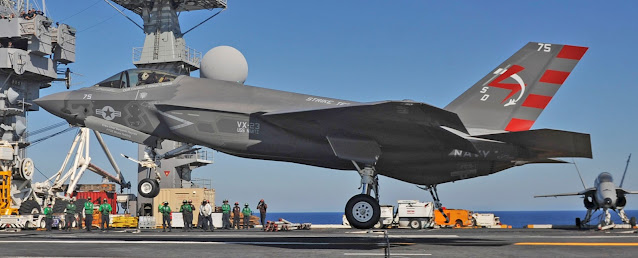2 August: Well, this is embarrassing. I inadvertently reversed the designations of Inflight and Free-Flight. Thanks to Oscar Meyer for the correction.
If you're unfamiliar with the function of the tailhook in carrier landings, I suggest you look at this blog post first: https://thanlont.blogspot.com/2011/12/brief-history-of-tailhook-design.html
While "Inflight" and "Free-flight" would seem to be very similar if not identical conditions, as terms of art in carrier aviation, they are very different although separated by a very fine line. For one thing, both occur when the airplane's tailhook picks up an arresting cable (Cross Deck Pendant or CDP, another term of art) before the landing gear touches the deck. The critical difference is the airplane's vertical velocity at that moment: in an free-flight engagement, it is negative (a descent) or zero; in a inflight engagement, it is positive (climbing).
Free-flight engagements are not uncommon and generally benign. They often occur simply because the hook point is almost always below the main landing gear wheels as the airplane approaches the deck and the hook point is not very far from picking up a CDP when it meets the deck: https://www.youtube.com/watch?v=AvqNyf4E0M8
The F-35C hook point location relative to the wheels with the airplane about to touch down is an exception, but it still looks like an free-flight engagement might sometimes result:
Note the location of the tailhook on this TBM relative to the main landing gear as the LSO gives its pilot the cut, which will result in the Avenger sinking relatively steeply to the deck:
Both the flat approach to a cut that was used before the flight deck became angled and the descending approach guided by the visual landing system used thereafter reduced the likelihood of an free-flight engagement because of the steepness of the descent combined with wind over deck resulted in the hook point being on the deck for a relatively short distance before the main gear touched down. But they occurred:
A inflight engagement, on the other hand, is likely to result in significant damage. It is usually caused when the pilot tries to salvage a bad approach with an aggressive addition of power and/or aft stick:
Some have suggested that this Corsair had simply bounced, given its early reputation for doing so. I think not. One possibility is that the pilot decided to initiate a wave off after being cut by the LSO, which was verboten. In any event, the outcome was almost certainly very hard on the airplane.
This looks more like a bounce but it's hard to be certain without seeing earlier pictures of this particular landing.
An SU-33 aborted landing to a Russian carrier could have resulted in one of the worst inflight engagements of all time:
Click HERE for the video.









5 comments:
I would assume a free flight engagement carried out to the point where the CDP ran out to its limit would take the hook and probably a good chunk of the aft end of the aircraft off? Seems once the hook engages the CDP it is not going to let go especially with the A/C moving forward and that the A/C structure is weaker than the than the CDP attachment? OR Would it be possible for the pendent drag to yank the A/C down onto the flight deck?
An interesting question that I don't know the answer to, other than it depends. There was a video on YouTube that I can't find now of an F8U attempting a test arrested landing at a shore facility (NATC?) that results in a free-flight engagement. If I remember correctly, the Crusader is brought to a halt, which is what I think will happen if the hook point holds.
If one searches the internet using '"Shake Rattle & Roll" VX-23 Carrier Suitability Testing' one may find how recent/current carrier aircraft are tested to their limits safely ashore before they go to get carrier qualified for fleet pilots. There are hair raising photos/videos/stories aplenty with free flight engagements with plenty of leeway to NOT INFLIGHT engage although sometimes the test pilots get close but only by accident. One old example of VX-23 Strike Test News at ISSUU 2015: https://issuu.com/nawcad_pao/docs/striketest2015_single
This excellent PDF about VX-23 & Carrier Suitability Testing with a photo of a Super Hornet inflight arrest test is here: Naval Aviation News SUMMER 2019 https://navalaviationnews.navylive.dodlive.mil/files/2019/09/NAN-Summer2019.pdf (9Mb)
"...It’s one thing to see a picture of a high-sink or off-center test point, but pictures don’t really do them justice.” “Salty Dog 120 conducts in-flight engagement during shake, rattle and roll testing at the MK-7 Arresting Gear at NAS Patuxent River. (Yes, this was intentional.)...”
Good slow motion video of an A4G Skyhawk (with RAN FAA aboard HMAS Melbourne) arresting with that long hook catching a wire whilst wheels off the deck.
A4G SKYHAWK HMAS Melbourne Arrest Slow Motion AWM F04987
https://www.youtube.com/watch?v=AvqNyf4E0M8
Post a Comment